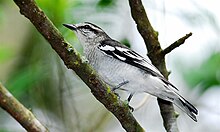Pied triller
| Pied triller | |
|---|---|

| |
| Scientific classification | |
| Domain: | Eukaryota |
| Kingdom: | Animalia |
| Phylum: | Chordata |
| Class: | Aves |
| Order: | Passeriformes |
| Family: | Campephagidae |
| Genus: | Lalage |
| Species: | L. nigra
|
| Binomial name | |
| Lalage nigra (Pennant, 1781)
| |
The pied triller (Lalage nigra) is a species of bird in the cuckooshrike family Campephagidae. It is found in Brunei, India, Indonesia, Malaysia, the Philippines, Singapore, and Thailand.
Taxonomy
In 1760 the French zoologist Mathurin Jacques Brisson included a description and an illustration of the pied triller in the second volume of his Ornithologie based on a specimen that had been collected in the East Indies. He used the French name Le Merle des Indes and the Latin name Merula Indica.[2] Although Brisson coined Latin names, these do not conform to the binomial system and are not recognised by the International Commission on Zoological Nomenclature.[3] In a section of a book by Johann Reinhold Forster published in 1781 the Welsh naturalist Thomas Pennant coined the binomial name Turdus niger for the pied triller and cited Brisson's work.[4] In 1922 the type location was restricted to Singapore by the American zoologist Outram Bangs.[5][6] The pied triller is now one of 20 species placed in the genus Lalage that was introduced in 1826 by the German zoologist Friedrich Boie.[7]
Three subspecies are recognised:[7]
- L. n. davisoni Kloss, 1926 – Nicobar Islands
- L. n. striga (Horsfield, 1821) – Malay Peninsula, Sumatra, Nias (west of north Sumatra), Bangka and Belitung (east of south Sumatra), Java, Karimunjawa (north of central Java) and Bali
- L. n. nigra (Pennant, 1781) – Borneo and satellites and Philippines
Gallery
-
Pied triller, Kuala Selangor, Malaysia, Aug 1994
-
Lalage nigra striga female
References
- ^ BirdLife International (2018). "Lalage nigra". IUCN Red List of Threatened Species. 2018: e.T22706651A130421238. doi:10.2305/IUCN.UK.2018-2.RLTS.T22706651A130421238.en. Retrieved 12 November 2021.
- ^ Brisson, Mathurin Jacques (1760). Ornithologie, ou, Méthode Contenant la Division des Oiseaux en Ordres, Sections, Genres, Especes & leurs Variétés (in French and Latin). Vol. 2. Paris: Jean-Baptiste Bauche. pp. 248–250. The two stars (**) at the start of the section indicates that Brisson based his description on the examination of a specimen.
- ^ Allen, J.A. (1910). "Collation of Brisson's genera of birds with those of Linnaeus". Bulletin of the American Museum of Natural History. 28: 317–335. hdl:2246/678.
- ^ Pennant, Thomas (1781). "Specimen Faunulae Indicae". In Forster, Johann Reinhold (ed.). Indische Zoologie oder systematische Beschreibungen seltener und unbekannter Thiere aus Indien (in Latin and German). Halle, Germany: Johann Jacob Gebauer. pp. 39–42 [41].
- ^ Bangs, Outram; Penard, Thomas E. (1919). "Notes on Philippine birds collected by Governor W. Cameron Forbes". Bulletin of the Museum of Comparative Zoology. 65 (4): 77–84 [80].
- ^ Mayr, Ernst; Greenway, James C. Jr, eds. (1960). Check-List of Birds of the World. Vol. 9. Cambridge, Massachusetts: Museum of Comparative Zoology. p. 197.
- ^ a b Gill, Frank; Donsker, David; Rasmussen, Pamela, eds. (July 2023). "Bristlehead, butcherbirds, woodswallows, Mottled Berryhunter, ioras, cuckooshrikes". IOC World Bird List Version 13.2. International Ornithologists' Union. Retrieved 14 December 2023.


